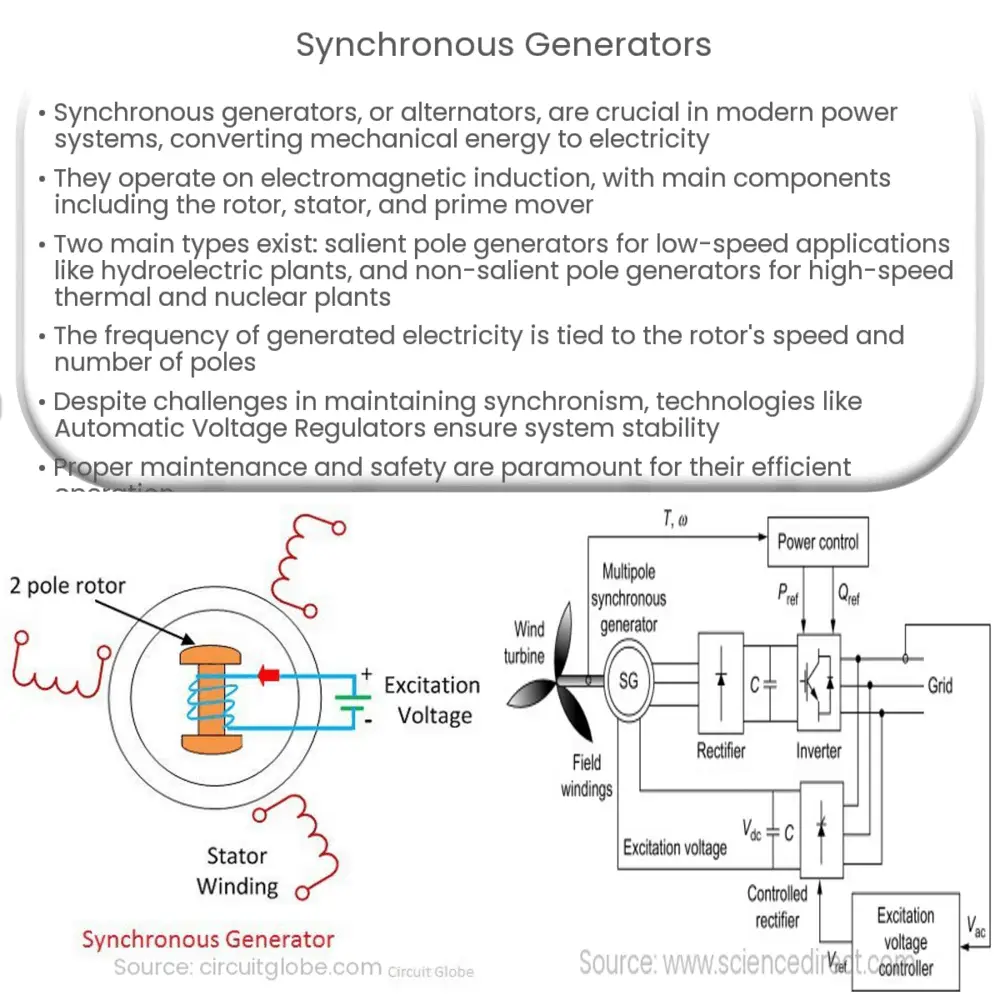Explore the principles, operation, types, and applications of synchronous generators, their role in power generation, and modern solutions to their challenges.

Synchronous Generators: An Essential Overview
Synchronous generators, also known as alternators, are one of the most essential components of modern power systems. They play a pivotal role in producing electricity in power plants across the globe.
Principles and Operation
Synchronous generators work on the principle of electromagnetic induction, a phenomenon discovered by Michael Faraday in 1831. This principle states that an electromotive force (EMF) is induced in a conductor when it is subjected to a changing magnetic field. Synchronous generators exploit this principle by rotating a conductor (the rotor) within a static magnetic field (the stator).
Components of Synchronous Generators
- Rotor: The rotor is the rotating part of the generator. It produces the magnetic field.
- Stator: The stator is the stationary part of the generator. It houses the windings where the EMF is induced.
- Prime Mover: This is the external source of mechanical energy that drives the rotor. It could be a steam turbine, a gas turbine, a water turbine, or an internal combustion engine.
Types of Synchronous Generators
There are two major types of synchronous generators: cylindrical rotor (salient pole) generators and non-cylindrical rotor (non-salient pole) generators.
- Salient Pole Generators: These generators have a large diameter and a short axial length. The poles of these generators are salient, or project outwards. They are typically used in hydroelectric power plants where rotation speed is relatively low.
- Non-Salient Pole Generators: These generators have a small diameter and a long axial length. The rotor poles are smooth and cylindrical. These types of generators are used in thermal and nuclear power plants where the speed of rotation is high.
Frequency of Generated Electricity
In a synchronous generator, the frequency of the generated electricity is directly proportional to the rotational speed of the rotor and the number of poles. This relationship is expressed as:
f = Np/120
Where:
- f is the frequency of the generated electricity,
- N is the speed of the rotor in RPM,
- p is the number of poles in the generator.
Benefits and Applications of Synchronous Generators
Synchronous generators are indispensable in modern society due to their versatile applications and numerous benefits. They are chiefly used in power plants to generate electric power, but also in ships, aircraft, and even some automobiles to provide auxiliary power.
One of the key benefits of synchronous generators is their ability to operate under varying load conditions without a significant change in frequency. This is because the frequency of the generated power is independent of the load and is primarily determined by the speed of the prime mover.
Moreover, synchronous generators can also improve the power factor of the overall system. A leading power factor can be achieved when the generator is over-excited, which can be beneficial in certain situations.
Challenges and Solutions
Despite their many advantages, synchronous generators are not without challenges. The primary issue is maintaining synchronism under varying load conditions. Any sudden increase in load can cause the generator to fall out of synchronism, leading to stability issues.
However, modern technology has provided solutions to these challenges. Automatic Voltage Regulators (AVRs) and governor control systems are commonly used to maintain the voltage and frequency of the generated power within acceptable limits, thus ensuring the stability of the system.
Maintenance and Safety
Maintenance is key to ensure the efficient operation of synchronous generators. Regular inspections and proper lubrication can prolong the lifespan of the generator and prevent unexpected breakdowns. Safety is also of utmost importance during operation and maintenance. Measures such as grounding the generator, wearing appropriate personal protective equipment, and adhering to operational guidelines are essential.
Conclusion
Synchronous generators, with their capacity to convert mechanical energy into electrical energy, serve as the backbone of power generation in today’s world. Their ability to operate under varied load conditions, improve power factor, and their wide-ranging applications, underscore their importance. While there are challenges associated with their operation, technological advancements continue to provide effective solutions. Through careful operation and maintenance, synchronous generators will continue to play a vital role in powering our world for years to come.


